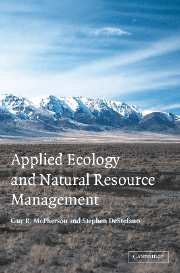4 - Succession
Published online by Cambridge University Press: 11 November 2009
Summary
Although ecosystems may be sufficiently stable to allow objective characterization, as described in the previous chapter, they are not temporally static entities. Rather, they are characterized by changes in species composition at various temporal scales. This chapter will focus on the factors that underlie transitions from one state to another at the temporal scales of years to decades. Changes in ecosystems at these temporal scales are termed succession (Figure 4.1).
Identifying states of ecosystems and determining causes of transitions from one state to another are fundamental to effective management. Specifically, management efforts should aim to achieve states that meet clearly specified objectives. In addition, managers must be cognizant of states that are not feasibly attainable and set management expectations accordingly.
It is also important to remember that wildlife communities are greatly influenced by vegetation succession. This relationship has been well documented in forests, but it also applies to other ecosystems, such as wetlands and grasslands. For example, Lloyd et al. (1998) found that changes in woody plant structure, primarily invasion of mesquite attributed to fire suppression, contributed to changes in the composition of grassland bird communities in former grasslands of southern Arizona. Managers should also recognize that habitat “quality” for many wildlife species can change with vegetation succession; good (or poor) quality habitat at one point in time often changes within a few years or decades (see below for a discussion of “habitat quality” and “habitat fitness”).
- Type
- Chapter
- Information
- Applied Ecology and Natural Resource Management , pp. 99 - 126Publisher: Cambridge University PressPrint publication year: 2002

